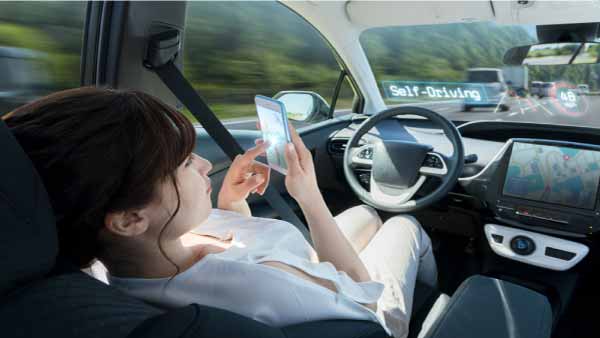Autonomous cars and connected vehicles are emerging technologies that are changing the way vehicles are used and driven around the world.
Self-driving cars are vehicles that can operate without human intervention in certain situations, using technologies such as sensors, cameras, radar, and navigation systems. These vehicles are designed to make decisions based on their environment and can navigate autonomously on roads and highways.
Connected vehicles, on the other hand, are those that are equipped with wireless communication technology that allows them to interact with other vehicles, devices, and systems in their environment. These vehicles can transmit information about your location, speed, direction, and other important data to other vehicles and transportation systems.
Together, autonomous cars and connected vehicles are transforming the world of transportation and mobility. These technologies can improve road safety, reduce traffic and congestion, and improve transport efficiency and sustainability. However, they also pose significant challenges in terms of privacy, cyber security, and legal liability, and their full adoption can take time and effort to fully implement.
Self-driving cars and sensors
Self-driving cars use a variety of sensors to sense their surroundings and make driving decisions. These sensors can include cameras, radars, lasers, and ultrasonic sensors.
Cameras are one of the most common sensors used in self-driving cars. The cameras can capture high-resolution images of the vehicle’s surroundings and can be used to recognize objects, traffic signs, pedestrians and other vehicles on the road.
Radars are also important sensors used in autonomous cars. Radars can detect objects through fog, rain and other obstacles, making them an important tool for long-distance obstacle detection.
Lasers, also known as lidars, are another type of sensor used in self-driving cars. The lasers can generate a 3D map of the vehicle’s surroundings, allowing the car to perceive the shape and location of objects in its environment.
Ultrasonic sensors are proximity sensors that can detect objects near the vehicle and are commonly used in driver assistance systems to assist in parking maneuvers and avoid low-speed collisions.
Overall, sensors are an essential part of autonomous car technology, enabling the vehicle to sense and respond to its environment autonomously and safely.
Self-driving cars and cameras
Cameras are an important part of the technology used in self-driving cars. These high-resolution cameras are used to provide a detailed view of the vehicle’s surroundings and allow the car to perceive objects, traffic signs, pedestrians and other vehicles on the road.
Cameras are also useful for traffic sign recognition, allowing the vehicle to detect and respond to traffic signs, such as traffic lights and stop signs.
In addition, cameras can be used to recognize and classify objects on the road, allowing the vehicle to determine how it should react to its surroundings. For example, an autonomous car can detect the presence of a pedestrian on the road and slow down or come to a complete stop to avoid a collision.
The cameras are also used for lane recognition and road line detection, allowing the vehicle to stay in its lane and navigate the road safely.
In general, cameras are an important part of autonomous car technology and allow the vehicle to perceive its surroundings more accurately and respond autonomously and safely to driving situations.
Self-driving cars and radars
Radars are a key component of the technology used in autonomous cars. These emit radio waves and then detect the echoes of those waves bouncing off nearby objects, allowing them to measure the distance, speed, and direction of objects in the vehicle’s environment.
Radars are especially useful in situations where visibility is limited, such as in foggy or heavy rain conditions. In addition, radars can detect objects at much greater distances than cameras or ultrasonic sensors, allowing the vehicle to anticipate driving situations further afield.
Radars are also capable of detecting the speed and direction of objects, allowing the vehicle to predict the movement of other vehicles on the road and adjust its own speed and direction accordingly. This is particularly important in dense or high-speed traffic situations, where the ability to anticipate and respond quickly to changes in the environment is essential for safe driving.
Overall, radars are an essential part of autonomous car technology, allowing the vehicle to autonomously detect and respond to objects in its environment and improve driving safety.
Self-driving cars and navigation systems
Navigation systems are an essential part of the technology used in autonomous cars. These systems are used to plan and execute a driving route, and allow the vehicle to navigate the road autonomously.
Navigation systems used in self-driving cars can use a variety of technologies, including 3D maps, global positioning systems (GPS), and camera and sensor technology to locate the vehicle in the environment.
In addition, navigation systems can be connected to a network of real-time information, such as live traffic and weather conditions, allowing the vehicle to plan an optimal route and avoid dangerous driving situations.
Navigation systems can also work in tandem with other autonomous car systems, such as sensors and cameras, to improve vehicle accuracy and safety. For example, if an unexpected object appears in the vehicle’s path, the navigation system can adjust the route in real time to avoid the object and keep the vehicle on a safe path.
In addition, navigation systems can be programmed to respect traffic laws and regulations, including speed limits, traffic signs and other regulations, allowing for safer and more reliable driving.
Overall, navigation systems are a critical part of the technology used in autonomous cars, allowing the vehicle to navigate the road autonomously and improving driving safety and efficiency.
On dangerous roads
Self-driving cars are designed to improve safety on the road, even on dangerous roads. In these situations, advanced safety systems and vehicle sensors can detect and respond to potentially dangerous driving situations, reducing the risk of accidents.
For example, on dangerous roads such as those with sharp curves, vehicle sensors can detect the vehicle’s speed, direction and incline, and adjust speed and direction to keep the vehicle safely on the road. Navigation systems can also be programmed to identify dangerous roads and adjust the route accordingly, avoiding dangerous driving situations whenever possible.
In addition, autonomous cars are equipped with a variety of advanced safety technologies, such as automatic emergency brakes, collision warning systems, and blind spot monitoring, which help prevent accidents and minimize injuries in the event of an accident.
Self-driving cars are designed to operate safely and effectively on all types of roads, including those that can be dangerous to human drivers. With their advanced safety technology and autonomous driving systems, these vehicles can significantly improve safety on the road and reduce the number of accidents and injuries.
How many autonomous cars are circulating in the world?
It is difficult to pinpoint how many autonomous cars are circulating in the world, since most companies developing this technology do not publish specific data on the number of vehicles they have deployed on the roads. In addition, the number of autonomous cars varies by country and region.
However, some technology and automotive companies have been known to deploy fleets of autonomous vehicles in tests in several countries. For example, Waymo, the autonomous vehicle unit of Alphabet (Google’s parent company), has been testing a fleet of self-driving cars in U.S. cities like Phoenix and San Francisco. Tests have also been carried out in Europe and Asia.
In addition, some transportation and logistics companies are implementing autonomous vehicles in their operations. For example, package delivery company UPS has been using autonomous trucks to transport packages between distribution centers in Arizona.
As technology advances and safety and regulatory issues are resolved, the number of autonomous vehicles is expected to increase worldwide in the coming years.
What kind of fuel do you use?
The type of fuel used by autonomous vehicles varies by vehicle manufacturer and model. Like conventional cars, autonomous vehicles can run on a variety of fuels, including gasoline, diesel, electricity, hydrogen, and natural gas.
Many of the autonomous vehicles in use today are electric or hybrid, as these vehicles are more energy efficient and emit fewer greenhouse gas emissions than conventional internal combustion vehicles. Electric vehicles use batteries to store energy and power the electric motors that drive the vehicle’s wheels. Hybrid vehicles combine a gasoline or diesel engine with an electric motor and battery, allowing them to switch between the two powertrains to improve fuel efficiency.
However, there are also autonomous vehicles that run on gasoline, diesel or compressed natural gas (CNG). These vehicles have conventional internal combustion engines and use fossil fuels to generate power. Although these vehicles emit more greenhouse gases than electric or hybrid vehicles, some manufacturers are working on technologies to improve fuel efficiency and reduce emissions from these vehicles.
In short, autonomous vehicles can use a variety of fuels, including gasoline, diesel, electricity, hydrogen and natural gas. As technology evolves and new forms of propulsion develop, it is possible that the fuel composition used by autonomous vehicles will change in the future.


